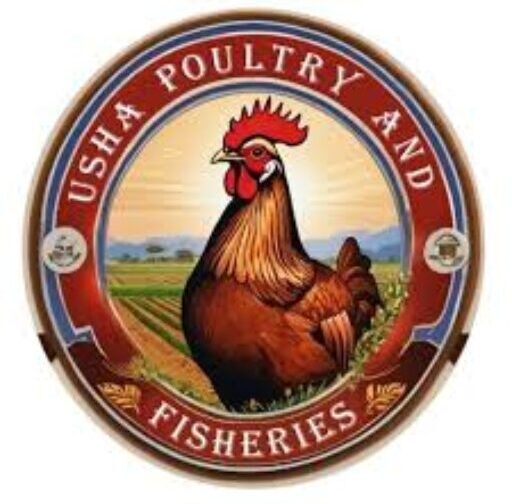Broiler farming is one of the fastest-growing businesses in the agriculture sector due to the increasing demand for chicken meat in India. At Usha Poultry and Fisheries, we have over 15 years of experience in raising broiler birds efficiently and profitably.
In this post, we’ll share essential information every beginner should know before starting broiler farming.

What is Broiler Farming?
Broilers are chickens specially bred for meat production. They grow faster and reach market weight in 35–45 days under proper management.
Broiler farming is a branch of poultry farming that focuses on raising meat-type chickens (broilers) specifically bred for rapid growth and high-quality meat production. Unlike layer farming, which is aimed at egg production, broiler farming is entirely focused on chicken meat production. Broilers grow fast, reaching market weight within 5–7 weeks, making it one of the most profitable and fast-returning farming businesses in agriculture.
What Are Broiler Chickens?
- Broilers are special breeds of chickens developed for meat production.
- They are capable of reaching 1.5–2.5 kg body weight in just 35–45 days under good management.
- Popular broiler breeds include Cobb 500, Ross 308, and Hubbard.
- They are known for their tender meat, efficient feed conversion, and rapid growth rate.
Housing Systems in Broiler Farming
Broiler chickens require proper housing to ensure healthy growth and prevent diseases. Common systems are:
- Deep Litter System (Most Common)
- Birds are reared on the floor covered with litter material like sawdust, husk, or straw.
- Suitable for both small and large-scale operations.
- Cage or Elevated System
- Less common in broilers but used in intensive farming.
- Helps in better waste management and disease control.
- Climate-Controlled Sheds
- Modern farms use environmentally controlled poultry houses with fans, coolers, and automatic feeders.
- Ensures uniform growth and better production efficiency.
Feeding in Broiler Farming
Feeding is the most crucial part of broiler farming, as it accounts for 60–70% of production cost.
- Starter Feed (0–2 weeks): High protein (20–22%) for rapid early growth.
- Grower Feed (2–4 weeks): Balanced feed for continued weight gain.
- Finisher Feed (4–6 weeks): Energy-rich feed for final body weight gain.
Clean, fresh drinking water must be available at all times.
Management Practices in Broiler Farming
- Brooding Management: Providing proper warmth during the first 10–14 days is crucial.
- Vaccination & Disease Control: Protection from diseases like Newcastle (Ranikhet), Gumboro, and Marek’s disease.
- Ventilation & Lighting: Good airflow and 23 hours of light in the initial weeks for growth.
- Biosecurity Measures: Disinfection, restricted farm access, and pest control to prevent disease outbreaks.
- Marketing: Birds are usually sold once they reach marketable weight (1.5–2.5 kg) within 35–45 days.
Benefits of Broiler Farming
- Quick Returns: Broilers are ready for sale within 6–7 weeks.
- High Profitability: Meat demand is always strong in domestic and export markets.
- Low Investment, High Output: Requires less space and produces faster results compared to other livestock.
- Employment Opportunities: Provides jobs in farming, feed production, processing, and distribution.
- Scalability: Can be started on a small farm and expanded into a commercial operation.
Challenges in Broiler Farming
- High risk of disease outbreaks due to fast growth and dense stocking.
- Rising feed costs directly affect profitability.
- Requires strict temperature and ventilation control.
- Market fluctuations in chicken prices can impact income.
Conclusion
Broiler farming is one of the most profitable and fast-growing sectors of the poultry industry. With proper housing, feeding, vaccination, and biosecurity measures, farmers can achieve high meat yields and profitability in a short period. Given the rising demand for chicken meat in India and worldwide, broiler farming is a sustainable and rewarding business opportunity.
At Usha Poultry and Fisheries, we provide expert guidance and resources for farmers to succeed in broiler poultry farming with modern techniques and best practices.
Key Requirements for Broiler Farming
- Housing (Poultry Shed)
- Well-ventilated, dry, and clean environment.
- 1 square foot of space per bird for comfortable growth.
- Chick Management
- Healthy chicks are the foundation of success.
- Choose chicks from a reliable hatchery (like ours at Usha Poultry and Fisheries).
- Feeding
- Use a balanced broiler feed containing proteins, vitamins, and minerals.
- Fresh, clean water must always be available.
- Lighting
- Adequate lighting encourages feeding and growth.
- Use 23–24 hours of light for chicks in the first week.
- Health Management
- Maintain cleanliness to prevent diseases.
- Follow a vaccination schedule as recommended by experts.
Advantages of Broiler Farming
- Quick returns within 1.5 months.
- High demand in local and urban markets.
- Can be started on a small scale and expanded gradually.
Common Mistakes to Avoid
- Overcrowding the birds.
- Using poor-quality feed.
- Ignoring vaccination and biosecurity measures.
Conclusion
Broiler poultry farming can be a profitable venture when done with proper planning, quality chicks, and good management. At Usha Poultry and Fisheries, we supply healthy broiler chicks and nutritious feed to help farmers achieve better results.
For expert guidance or to place an order for chicks and feed, contact us today:
📞 WhatsApp +91 97540 87899
📧 e-mail- mitadhar2k13@gmail.com
You can Visit our Youtube Channel for more information.

